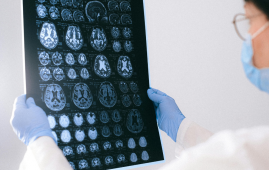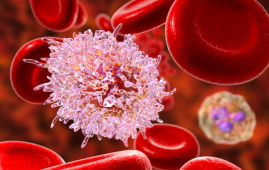

Uncovering the Brain’s Own Defense Against Oxidative Stress
Hemoglobin, long recognized for its role in transporting oxygen in red blood cells, has now been identified as a natural antioxidant within brain cells. Researchers at the Institute for Basic Science (IBS) in Daejeon, South Korea, under the leadership of Director C. Justin Lee, have discovered hemoglobin localized in the nucleolus of astrocytes, specialized star-shaped glial cells responsible for supporting neuronal function and maintaining homeostasis. In this environment, hemoglobin functions as a “pseudoperoxidase,” efficiently neutralizing hydrogen peroxide (H₂O₂), a reactive oxygen species that can cause significant oxidative damage to neurons.
Explore All Neurology CME/CE Conferences
This discovery is particularly significant because oxidative stress has been implicated in the pathophysiology of multiple neurodegenerative conditions, including amyotrophic lateral sclerosis (ALS), Parkinson’s disease, Alzheimer’s disease, and the cognitive decline associated with aging. By revealing a previously unrecognized intrinsic antioxidant mechanism, the study suggests that hemoglobin within astrocytes acts as a frontline defense, mitigating ROS-induced damage and maintaining cellular integrity. For clinicians, understanding this mechanism underscores the potential of targeting endogenous antioxidant systems rather than relying solely on exogenous antioxidants, which often fail to penetrate the blood–brain barrier effectively or exhibit off-target effects.
“The key was to uncover hemoglobin’s antioxidant potential in the brain and design a ‘first-in-class’ compound that could selectively enhance it. By boosting a natural defense mechanism rather than introducing an external antioxidant, we achieved strong and lasting protection across multiple disease models associated with oxidative stress.”
- Dr. Won Woojin, first author
KDS12025 Enhances Antioxidant Role of Hemoglobin
Building on the insight of hemoglobin’s intrinsic antioxidant function, the research team developed KDS12025, a small, water-soluble molecule capable of crossing the blood–brain barrier. KDS12025 selectively binds to the heme center of astrocytic hemoglobin, significantly enhancing its ability to decompose H₂O₂ by nearly 100-fold in laboratory conditions, without impairing hemoglobin’s critical oxygen-carrying function.
Preclinical studies demonstrated profound neuroprotective effects across multiple disease models. In ALS mouse models, treatment with KDS12025 delayed disease onset, slowed neuronal degeneration, and increased survival. Parkinson’s models showed restoration of motor coordination, while Alzheimer’s models exhibited marked improvement in memory retention and cognitive performance. Additionally, aging mice experienced a substantial extension in median lifespan from two to three years, indicating that bolstering hemoglobin activity may counteract age-associated oxidative stress. Beyond the CNS, KDS12025 also demonstrated systemic benefits, reducing neuroinflammation and mitigating tissue damage in related oxidative stress conditions.
These findings suggest that pharmacologically enhancing hemoglobin’s antioxidant capacity could offer a novel therapeutic strategy for HCPs managing patients with neurodegenerative disorders. By augmenting the brain’s natural defense mechanisms, KDS12025 presents an opportunity to prevent neuronal damage, preserve astrocytic function, and potentially slow disease progression, an approach that could complement existing symptomatic therapies and redefine the treatment landscape for oxidative stress–related neurological conditions.
Clinical Implications and Future Directions
For healthcare professionals, these findings emphasize a paradigm shift: enhancing the brain’s intrinsic antioxidant systems may offer more targeted, safer interventions than traditional exogenous antioxidants. Hemoglobin’s modulation provides a new avenue to preserve neuronal function, reduce astrocytic inflammation, and mitigate neurodegeneration. As Dr. Won Woojin, first author, notes, “By boosting hemoglobin’s activity, we reversed oxidative damage, preserved neurons, and maintained healthy brain function.” Future research will focus on α- and β-globin roles, KDS12025 refinement for human trials, and exploring applications in autoimmune and age-related diseases.
This work represents a major step in neurotherapeutics, transforming hemoglobin from a simple oxygen carrier into a precision antioxidant defense system capable of addressing multiple brain disorders.
For More information:
Woojin, W., et al. (2025). Hemoglobin as a pseudoperoxidase and drug target for oxidative stress-related diseases. Signal Transduction and Targeted Therapy. doi.org/10.1038/s41392-025-02366-w.
more recommended stories
 Innovative AI Boosts Epilepsy Seizure Prediction by 44%
Innovative AI Boosts Epilepsy Seizure Prediction by 44%Transforming Seizure Prediction in Epilepsy Seizure.
 Hypnosis Boosts NIV Tolerance in Respiratory Failure
Hypnosis Boosts NIV Tolerance in Respiratory FailureA New Approach: Hypnosis Improves NIV.
 Bee-Sting Microneedle Patch for Painless Drug Delivery
Bee-Sting Microneedle Patch for Painless Drug DeliveryMicroneedle Patch: A Pain-Free Alternative for.
 AI Reshapes Anticoagulation in Atrial Fibrillation Care
AI Reshapes Anticoagulation in Atrial Fibrillation CareUnderstanding the Challenge of Atrial Fibrillation.
 Global Data Resource for Progressive MS Research (Multiple Sclerosis)
Global Data Resource for Progressive MS Research (Multiple Sclerosis)The International Progressive MS Alliance has.
 AI Diabetes Risk Detection: Early T2D Prediction
AI Diabetes Risk Detection: Early T2D PredictionA new frontier in early diabetes.
 Cancer Cells Learn to Self-Report: A New Frontier in Immunotherapy
Cancer Cells Learn to Self-Report: A New Frontier in ImmunotherapyHow a Drug Complex Enables Immune.
 Staphylococcus Shows Complex Enzyme Redundancy, Study Finds
Staphylococcus Shows Complex Enzyme Redundancy, Study FindsA Bacterial Pathogen That Refuses to.
 Parkinson’s Disease Care Advances with Weekly Injectable
Parkinson’s Disease Care Advances with Weekly InjectableA new weekly injectable formulation of.
 New Blood Cancer Model Unveils Drug Resistance
New Blood Cancer Model Unveils Drug ResistanceNew Lab Model Reveals Gene Mutation.

Leave a Comment